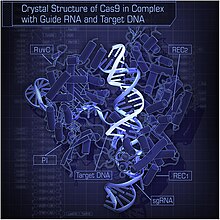Clustered regularly interspaced short palindromic repeats (CRISPR, pronounced crisper) are segments of prokaryotic DNA containing short repetitions of base sequences. Each repetition is followed by short segments of "spacer DNA" from previous exposures to a bacteriophage virus or plasmid.
The CRISPR/Cas system is a prokaryotic immune system that confers resistance to foreign genetic elements such as those present within plasmids and phages, and provides a form of acquired immunity. CRISPR spacers recognize and cut these exogenous genetic elements in a manner analogous to RNA interference in eukaryotic organisms. CRISPRs are found in approximately 40% of sequenced bacterial genomes and 90% of sequenced archaea.
 Cas9 (CRISPR associated protein 9) is an RNA-guided DNA endonuclease enzyme associated with the CRISPR(Clustered Regularly Interspaced Short Palindromic Repeats) adaptive immunity system in Streptococcus pyogenes, among other bacteria. S. pyogenesutilizes Cas9 to memorize and later interrogate and cleave foreign DNA, such as invading bacteriophage DNA or plasmid DNA. Cas9 performs this interrogation by unwinding foreign DNA and checking whether it is complementary to the 20 basepair spacer region of the guide RNA. If the DNA substrate is complementary to the guide RNA, Cas9 cleaves the invading DNA. In this sense, the CRISPR-Cas9 mechanism has a number of parallels with the RNA interference (RNAi) mechanism in eukaryotes.
Cas9 (CRISPR associated protein 9) is an RNA-guided DNA endonuclease enzyme associated with the CRISPR(Clustered Regularly Interspaced Short Palindromic Repeats) adaptive immunity system in Streptococcus pyogenes, among other bacteria. S. pyogenesutilizes Cas9 to memorize and later interrogate and cleave foreign DNA, such as invading bacteriophage DNA or plasmid DNA. Cas9 performs this interrogation by unwinding foreign DNA and checking whether it is complementary to the 20 basepair spacer region of the guide RNA. If the DNA substrate is complementary to the guide RNA, Cas9 cleaves the invading DNA. In this sense, the CRISPR-Cas9 mechanism has a number of parallels with the RNA interference (RNAi) mechanism in eukaryotes.
Spacer DNA or intergenic spacer (IGS) is a region of non-coding DNA between genes. The term is used particularly for the spacer DNA between the many tandemly repeated copies of the ribosomal RNA genes.
CRISPR is part of a normally occurring bacterial process. Bacteria may incorporate foreign DNA and even scavenge damaged DNA from their environment.

The CRISPR/Cas (Clustered Regularly Interspaced Short Palindromic Repeats/CRISPR associated nucleases) system was originally discovered to be an acquired immune response mechanism used by archaea and bacteria. It has since been adopted for use as a tool in the genetic engineering of higher organisms.
Designing an appropriate gRNA is an important element of genome editing with the CRISPR/Cas system. A gRNA can and at times does have unintended interactions ("off-targets") with other locations of the genome of interest. For a given candidate gRNA, these tools report its list of potential off-targets in the genome thereby allowing the designer to evaluate its suitability prior to embarking on any experiments.
I was diagnosed as HEPATITIS B carrier in 2013 with fibrosis of the
ReplyDeleteliver already present. I started on antiviral medications which
reduced the viral load initially. After a couple of years the virus
became resistant. I started on HEPATITIS B Herbal treatment from
ULTIMATE LIFE CLINIC (www.ultimatelifeclinic.com) in March, 2020. Their
treatment totally reversed the virus. I did another blood test after
the 6 months long treatment and tested negative to the virus. Amazing
treatment! This treatment is a breakthrough for all HBV carriers.